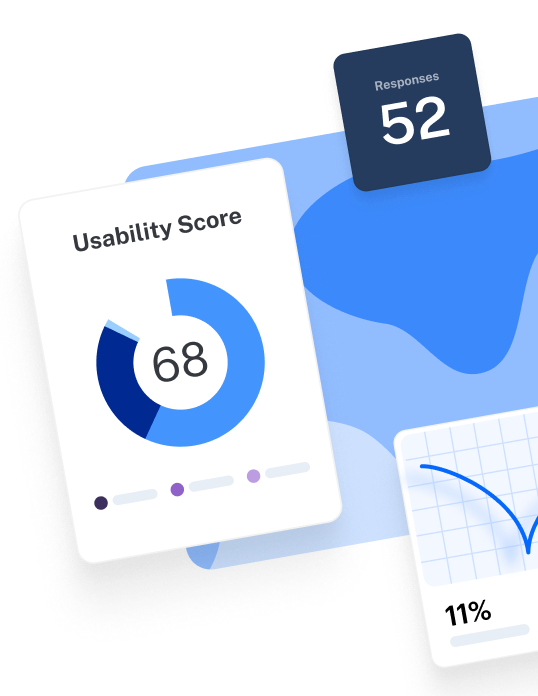User experience (UX) is an essential factor in your company's success. No matter how brilliant your brand or how essential your product, if your website or app is slow, difficult to navigate, or unintuitive, users will turn away.
Whether you’re catering to desktop or mobile users, the combination of good UX and seamless functionality is key to landing more sales. To help you leverage the power of great UX, sway stakeholders, and support your strategic decisions, we've compiled a list of up-to-date statistics for 2025.
Here’s what we’ll cover:
- User experience statistics: Top picks for 2025
- UX stats: Our UX industry research
- UX statistics: The importance of first impressions
- UX statistics: UX makes or breaks the customer experience
- UX statistics: The cost of bad UX design
- UX statistics: The future of UX research and design
User experience statistics: Top picks for 2025
We searched high and low for the most insightful UX research and statistics, and these are the four that highlighted just how critical UX is for success.
1. 77% of brands believe CX is a key competitive differentiator. (Source)
Customer experience shapes users’ perceptions and loyalty through their cumulative interactions with a company, from first contact to post-sale support.
A good user experience, characterized by personalized service, agility, and effective communication, fosters customer loyalty and converts customers into brand advocates.
2. Every $1 invested in UX design yields a return of $100 (ROI = 9,900 %). (Source)
Forrester's research indicates that investing in user experience design greatly increases a business's return on investment, impacting more than just direct revenue. It improves customer loyalty, streamlines operational efficiency, and lowers customer support costs.
3. 70% of Gen Z users want websites to intuitively know what they want. (Source)
Gen Z, soon to be the main consumer force, demands online experiences that are personalized but also predictive. For businesses, this means leveraging cutting-edge technology and AI research tools to design web interfaces that meet and anticipate Gen Z's preferences.
4. Improving UX design to increase customer retention by just 5% can translates to a 25% rise in profit. (Source)
Effective UX design creates a positive emotional attachment to the brand and helps retain customers. In turn, retained customers tend to make more purchases and advocate for the brand, leading to organic growth and reduced marketing expenses.
UX stats: Our UX industry research
Next up, our own research. We surveyed industry experts and clients to understand how businesses are shaping their UX strategies. We also uncovered insights on the significant impact of user experience on organizational success and the emerging trends that are defining the industry's future.
We’ve included some of the most interesting findings below, but you can also read the full reports here:
Here’s what we found.
5. 82% of companies in our audience have at least one dedicated UX researcher. (Source)
There’s an increasing recognition of the value of UX research in guiding product development and enhancing customer satisfaction. UX researchers interpret user behavior, preferences, and needs through usability tests, surveys, and interviews. These insights are then used to guide and refine product design and functionality, ensuring the end products are user-friendly and meet the expectations of the target audience.
6. 74% of respondents believe research is partially or fully effective in determining decision-making. (Source)
There’s a substantial shift towards using UX research to define evidence-based strategies in product development. This data-informed approach ensures products are aligned with current user needs, as well as adaptable to future research trends and demands—fostering sustainable growth and competitive advantage.
7. A majority of organizations are on their way to becoming research-mature, but only 3% have reached the highest stage of research maturity to achieve superior business results. (Source)
Our Research Maturity Model Report highlights a significant gap in the research maturity landscape, where only 3% of organizations have attained the highest level of research maturity. These 3% of organizations demonstrate a profound commitment to integrating research across all aspects of their operations.
They’re more likely to conduct frequent and generative research, focusing on discovering new opportunities and deeply understanding customer needs. This advanced level of research maturity is closely linked to enhanced business outcomes, including reduced time-to-market, increased revenue, and improved brand perception.
8. Organizations with mature research practices are 1.9x more likely to report improved customer satisfaction. (Source)
The same report also found that organizations with advanced research practices prioritize understanding customer needs through a variety of UX research methods and data sources. They go beyond simply enhancing product usability—they deeply integrate research into every stage of the product life cycle, from initial product discovery to post-launch evaluation.
As a result, they are more adept at customer retention and increasing active user engagement, moving away from cost-saving outcomes to focus on value creation through continuous, customer-centric innovation.
UX statistics: The importance of first impressions
The initial interaction a user has with a digital product can significantly influence their overall perception and future engagement. A positive first impression typically leads to increased user engagement, loyalty, and a higher likelihood of conversions.
Conversely, a negative first impression and experience often results in high bounce rates, lost potential customers, and tarnished brand reputation. These insights emphasize the critical role of creating engaging, user-friendly interfaces right from the first interaction, ensuring users are captivated to explore further.
Here are some quick-fire statistics highlighting how first impressions affect user decisions:
9. It takes about 50 milliseconds (that’s 0.05 seconds) for users to form an opinion on your website, including whether they like your site or not, and whether they’ll stay or leave. (Source)
10. 88% of internet users are less likely to return to a website after a poor user experience. (Source)
11. A well-designed user interface (UI) can increase a website's conversion rate by up to 200%, and a better UX design can achieve conversion rates of up to 400%. (Source)
12. 75% of users admit to making judgments about a company’s credibility based on their website’s design. (Source)
UX statistics: UX makes or breaks the customer experience
UX design directly impacts customer experience, influencing key metrics like engagement, retention, and conversion rates. Here’s some key UX statistics highlighting how good UX design not only enhances user satisfaction, but also measurably boosts business performance:
13. On average, companies that put in the work to improve customer experience see a 42% improvement in customer retention, a 33% improvement in customer satisfaction, and a 32% increase in cross-selling and up-selling. (Source)
14. Consumers place high importance on ‘previous good CX with the brand’ as their top criteria when considering a new purchase. (Source)
15. 66% of consumers say they will share personal data about themselves if they think it will elevate their customer experience. (Source)
16. 60% of consumers report that they will become repeat buyers after a personalized purchasing experience. (Source)
17. 49% of consumers have left a brand in the past due to poor user experience. (Source)
18. 77% of brands believe customer experience is a key competitive differentiator. (Source)
19. 94% of consumers prioritize easy navigation as the most important feature in digital platforms, while a significant 83% also consider a beautiful and updated UX design essential. (Source)
UX statistics: Mobile users want more
Good mobile UX design leads to increased engagement and customer retention, while failure to meet these expectations often results in users abandoning the app or website. In this section, we’ll highlight the growing demands of mobile users for streamlined, responsive, and user-friendly interfaces:
20. The average mobile bounce rate is 67.4%, while the average desktop is only 32%. (Source)
21. 75% of consumers value the availability of fully self-service customer care options on mobile platforms, highlighting the importance of mobile accessibility in meeting their inquiry needs. (Source)
22. Online shoppers want, and even expect, an easy and well-informed mobile experience for enjoyable shopping, with 73% of shoppers preferring to watch a short video to learn about a product or service. (Source)
23. 67% of mobile users say that when they visit a mobile-friendly site, they're more likely to buy a site's product or service. (Source)
24. 48% of customers say if a website or app isn't mobile-optimized, it’s a clear indication that the business doesn’t care. (Source)
25. 66% of mobile sites place tappable elements too close to each other, and 32% of sites have tappable elements that are too small—making it difficult for website visitors to navigate the mobile interface reliably. (Source)
Bring the power of user research to your entire mobile ecosystem
Design, test, and validate every part of your mobile experience with the Maze mobile app—from early prototypes to live app interactions.
UX statistics: The cost of bad UX design
Users characterize bad UX as confusing navigation, slow load times, and unresponsive design—all things that can drastically undermine customer experience. Neglecting UX design can result in a loss of customer engagement, and can negatively impact a business' bottom line.
Here’s some of the data on how bad UX design can lead to user frustration, high bounce rates, and a decline in brand loyalty.
26. 86% of consumers will leave a brand they trusted after only two poor customer experiences. (Source)
27. 73.1% of web designers believe that a non-responsive design is the top reason visitors leave a website. (Source)
28. 52% of US consumers sometimes or always walk away from purchases due to a bad user experience. (Source)
29. People are more likely to rant about a negative experience than rave about a positive one. Around 13% will tell more than 20 people. (Source)
UX statistics: The future of UX research and design
The future of UX design holds many exciting developments—here are six emerging trends that will reshape UX research, design, strategies, and practices in the years ahead.
30. Personalization is a crucial trend in mobile marketing, with 90% of marketing experts agreeing that it significantly increases business profitability. (Source)
Personalization involves tailoring experiences to individual user preferences, which impacts customer engagement and satisfaction. Customers increasingly expect personalized experiences across products, meaning UX designers need to find more ways to personalize each user’s experience.
31. Data-driven organizations are 23x more likely to acquire new customers and 19x more likely to be profitable. (Source)
Data-driven organizations are increasingly coming out on top by leveraging customer insights for targeted marketing strategies, employing advanced analytics for product decision-making, and optimizing resource allocation. These efforts lead to higher customer engagement and returns, highlighting the importance of user research for business growth and success.
32. Nearly 16% of the world’s population, or more than 1.3 billion people, live with disabilities (Source), but 90% of websites are inaccessible to people who rely on assistive technology. (Source)
Web accessibility ensures that all users can access and interact with online content simply and effectively. This includes people with visual, cognitive, physical, and auditory disabilities. Accessible products and include design attract a wider audience and achieve higher search engine rankings, making them beneficial for both users and website owners.
33. Many teams are conducting research, including designers (70%), UX researchers (63%), and product managers (42%). (Source)
Democratization in user research involves a broader participation of various stakeholders in the research process, rather than restricting it to specialized researchers. This approach scales UX research, fosters greater knowledge-sharing in organizations and encourages all teams to use UX research to make user-centric decisions.
34. 64% of business owners in 2023 believe that AI can improve customer relationships and satisfaction. (Source)
While at first glance, many people think of AI and removing the ‘human touch’ from services, the research shows that it can actually improve customer interactions. AI in UX design can help personalize customer experiences, provide timely and accurate responses, and efficiently handle large volumes of customer interactions.
35. One fifth of researchers currently use AI in their research, with an additional 38% planning to utilize it in the future. (Source)
AI is now present in most industries, and UX is no different. Design and research industries are adapting for the presence of AI in user research, and it’s time for UX teams to get on board. This trend isn’t going anywhere.
Build winning products with UX research and design
If you want to build user-centric products, adopting a continuous product research mindset is crucial. This involves frequently connecting with users to get an up-to-date understanding of their wants and needs.
Connecting with your customer shouldn’t be a hassle—not for you, and not for them. Maze seamlessly supports your user research efforts with a comprehensive suite of UX research tools, including user interviews, UX surveys, usability testing, card sorting, and more.
While the statistics above give insights into the current state of UX, they also show the future opportunities awaiting teams that prioritize building user-centric products. Start learning about your users today.
Frequently asked questions about UX statistics
Are UX designers in demand for 2025?
Are UX designers in demand for 2025?
Yes, UX designers are anticipated to be in high demand in 2025. The U.S. Bureau of Labor Statistics projects a 16% growth rate from 2021 to 2031 for web developers and digital designers, which includes UX designers.
Is UX research growing?
Is UX research growing?
Yes, UX research is indeed growing and evolving. In our Future of User Research Report, 55% of respondents said demand for user insights increased over the past year. This trend shows the growing importance of UX research in shaping business decisions and product strategies, despite ongoing challenges like time and budget constraints.
Is AI going to replace UX designers?
Is AI going to replace UX designers?
No, AI is not expected to replace UX designers, but rather enhance their capabilities and contribute to the design process. AI can't replicate human empathy and creativity—crucial for understanding user needs and making intuitive design judgments.





